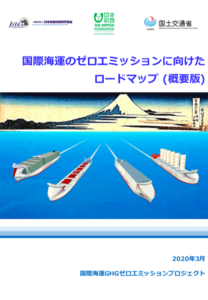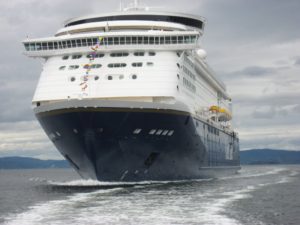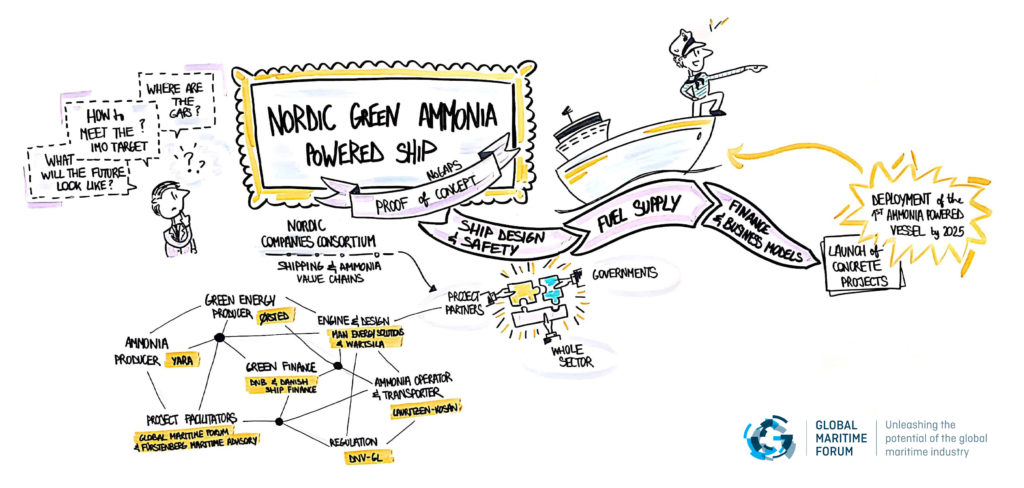Maritime Ammonia: ready for demonstration
By Trevor Brown on May 07, 2020
At least four major maritime ammonia projects have been announced in the last few weeks, each of which aims to demonstrate an ammonia-fueled vessel operating at sea.
In Norway, Color Fantasy, the world’s largest RORO cruise liner, will pilot ammonia fuel. Across the broader Nordic region, the Global Maritime Forum has launched NoGAPS, a major consortium that aims to deploy “the world’s first ammonia powered deep sea vessel” by 2025.
In Japan, a new industry consortium has launched that goes beyond on-board ship technology to include “owning and operating the ships, supplying ammonia fuel and developing ammonia supply facilities.” And the Ministry of Land, Infrastructure, Transport and Tourism (MLIT), which published its roadmap last month, aims to demonstrate ammonia fuel on “an actual ship from 2028” — specifically, a 80,000 dwt ammonia-fueled bulk carrier.
Only a few months ago, in December 2019, I was reporting that the idea of ammonia-fueled ships was moving beyond academic analysis and entering the design phase. Already, the sector is pushing past design and into the demonstration phase.
The first demonstration vessel was announced in January 2020: the Viking Energy, which will be operating on a 2 MW ammonia-fed fuel cell from 2024.
Now, the race is truly on to demonstrate ships fueled by ammonia. The winners will be the regions that are first to deploy low-carbon vessels and bunkering infrastructure. The prize will be a dominant position in the value chains that enable the decarbonization of global shipping. The contest is just starting but, today, the Nordics and Japan are leading the pack.
Japan’s Roadmap for Zero Emissions of International Shipping

Japan wants to align its commitment to reducing emissions with its status as “one of the world’s leading shipping and shipbuilding nations.” Through its International Shipping GHG Zero Emissions project, MLIT hopes to “lead the formulation and promotion of international measures,” and support the technology development “necessary to further enhance Japan’s competitive advantage.”
MLIT’s Roadmap for Zero Emissions of International Shipping, which was published at the end of March 2020, describes this collaboration between industry, academia, and government, and the low-carbon technology portfolio that they are developing.
First, we will work on the necessary international rule development, [then] promotion of technological development and demonstration, and aim for commercial operation of the ultimate eco-ship “Zero Emission Ship” that does not emit greenhouse gases by 2028.
Japan Ministry of Land, Infrastructure, Transport and Tourism, Roadmap for Zero Emissions of International Shipping, March 2020
Ammonia is not the only option being pursued here: three other low-carbon vessels are under development as well, including a hydrogen fueled ship, a conventional ship with a system for on-board CO2 capture, and an LNG-fueled ship designed to reduce emissions through efficiency (low speed, and wind-assist technologies).
For each of these four options, “we will investigate the possibility of introducing an actual ship from 2028 to 2030 and identify technical issues.”

MLIT’s ammonia eco-ship design is based on an 80,000 dwt bulk carrier, which “is assumed to be Japan-Australia route.” It employs dual-fuel engine technology “that has a proven track record with methanol, LPG, etc” (this describes the MAN ES ammonia engine now in development), which requires a pilot fuel, presumably fossil-based. This cannot therefore be a truly zero-emission vessel due to the continued use of a hydrocarbon pilot fuel. Nonetheless, in this “ultra-low carbon” ship, a “CO2 reduction effect of 91.9% is expected compared to the conventional ship of the same type.”
MLIT’s research areas for 2021 are worthy topics. First, a “study on methane slip reduction measures in LNG combustion.” (Another Ammonia Energy article, published yesterday, highlights the impact of methane slip in the life-cycle analysis of shipping fuels.) Second, MLIT “will investigate the actual situation of N2O emission from ammonia combustion and investigate the possibility of reduction.” Third, is the crucial job of “reviewing safety regulations necessary for introducing alternative fuels.”
Japanese consortium: Imabari, MAN ES, Mitsui, ClassNK, Itochu ENEX, and Itochu
Last week saw the launch of another industry consortium in Japan, very closely aligned with the roadmap developed by MTIL. Five Japanese heavyweights are now working with MAN ES to “develop ships equipped with a main engine using ammonia as its main fuel.”
The purpose of the joint agreement is not limited to the development of ships equipped with an Ammonia-fueled Engine, but also extends to the question of owning and operating the ships, supplying ammonia fuel and developing ammonia supply facilities. The consortium intends to promote initiatives to reduce GHGs with the cooperation of domestic and overseas companies, as well as the relevant government agencies.
ClassNK announcement, Joint Agreement Reached for GHG Zero-Emission Ship, April 30, 2020
The consortium members span much of the value chain for ammonia as a maritime fuel, and each “will concentrate on its own, respective area of expertise.”
- Imabari Shipbuilding “will develop and design the ship that mounts a series of systems practically and safely on board, such as an ammonia storage tank as a marine fuel, a fuel supply system, and a main engine.”
- MAN ES “will develop an Ammonia-fueled Engine and provide the key data necessary for design a ship equipped with an Ammonia-fueled Engine.”
- Mitsui E&S Machinery, which will build the engine from MAN’s design, “contributes to this project from a supplier’s point of view, verifying the safety and reliability of the entire life cycle of the propulsion system, including manufacturing and commissioning at the factory.”
- ClassNK, the main maritime classification society in Japan, “will conduct a third-party safety assessment and … will contribute to the industry widely by developing guidelines based on the results obtained.”
- Itochu ENEX, which distributes bunker fuels, “will contribute to the spread of ammonia fuel for ships by setting up an ammonia fuel distribution network.”
- Itochu Corporation is a member of the Green Ammonia Consortium in Japan, and it has perhaps the biggest role in this project, including ultimately “owning and operat[ing] ammonia fueled ships.”
ITOCHU will promote to materialize the integrated project, leading the formation of partnerships in Japan and overseas by making use of networks with various industries / companies such as shipper, shipping company, ammonia producer and/or any other parties related to ammonia fuel supply chain, owning and operate ammonia fueled ships, and jointly developing a facility for supplying ammonia fuel for ships with ITOCHU ENEX.
ClassNK announcement, Joint Agreement Reached for GHG Zero-Emission Ship, April 30, 2020
Color Fantasy

Also last week, Color Line announced a 16-party consortium based in Norway that will deliver “a case study with Color Fantasy as the object.” The Color Fantasy is the world’s largest RORO (“roll-on, roll-off,” referring to the car deck) cruise liner, and operates between Oslo and Kiel in Germany.
Color Line launched this consortium because it “realizes that it will be difficult to meet the UN’s climate objectives and the shipping industry’s ambition for major climate cuts without doing anything radical with fuel.”
Color Line has brought technology companies as well as Carnival and other shipping companies to see if ammonia can become the zero-emission fuel of the future …
The pilot study is underway and will during the year identify technological solutions that meet all regulatory requirements, not least on safety. The study will use Color Fantasy as an example for technical description of green solution, feasibility / risk analysis, emission calculations, cost-benefit and to investigate support possibilities …
The Norwegian Maritime Directorate is involved in the work that looks at safety and regulations. The Port of Oslo is studying what it takes to refill ammonia at the quay.
Teknisk Ukeblad, Pilotstudie: Color Fantasy på ammoniakk, April 27, 2020
Color Fantasy currently burns around 25,000 tons of bunker fuel each year and, if the vessel is converted, it will require roughly 60,000 tons of green ammonia, which must be stored and distributed locally.
Until now, every ammonia-fueled ship proposal has been for a freight or service vessel, not a passenger vessel. According to Jan Helge Pile, Color Line’s environmental manager, “We have to turn every stone and see what is possible … Color Line is prepared for it to prove challenging to use ammonia, which is toxic, on board a passenger ship.”
In addition to Color Line and Carnival, the consortium members include ABB, Wärtsilä, the Norwegian Maritime Directorate, Torghatten Transport Company, DFDS, Carnival, SINTEF, Wilhelmsen, Altera Infrastructure, Seatrans, Yara, Port of Oslo, Florø Hamn, Oshima Shipbuilding, and the classification society DNV GL.
Nordic Green Ammonia Powered Ship (NoGAPS)
In March 2020, Nordic Innovation announced funding for a series of five clean maritime projects, including the ZEEDS Consortium, about which we’ve written previously, and a new project entitled Nordic Green Ammonia Powered Ships (NoGAPS).
The project will develop a holistic proof of concept and roadmap for the construction of the world’s first ammonia powered deep sea vessel.
Nordic Innovation announcement, Nordic projects to reduce CO2 emissions in the maritime sector, March 20, 2020
The consortium partners in NoGAPS include the Global Maritime Forum; ship owner/operator Lauritzen Kosan, which specializes in bulk transport of chemicals and gas, including ammonia; ammonia producer Yara; engine manufacturers Wärtsilä and MAN Energy Solutions; classification society DNV GL; renewable energy producer Ørsted; project facilitator Furstenburg Maritime Advisory; and, from the finance side, Danish Shipping Finance and DNB.
While there is little additional information about the project at this time, the consortium kicked off with a meeting at the end of April, following which the Global Maritime Forum shared the following infographic via its Twitter account — targeting 2025 as the date for deployment of the ammonia powered vessel.
